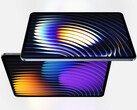In our review, the Xiaomi Pad 7S Pro impresses with a great balance between a strong performance and a mid-range price tag (starts at 500 Euro at Trading Shenzhen). In addition to a fast memory setup up to 16 GB RAM and a 1 TB UFS-4.1 flash memory, the affordable price of the Pad 7S Pro is also not noticeable in the choice of processor. The in-house ARM chipset XRing O1 offers a top notch performance at flagship level. The mid-rage tablet plays with its SoC in the high-end league, especially when it comes to graphics power.
Large Android tablet does not use an OLED screen
In our review, we also liked the LC display of the Pad 7S Pro, which can be a very good decision due to the lack of pulse width modulation. Even compared to a tablet with OLED technology, the Xiaomi Pad shows a high-quality LCD and is therefore an attractive alternative of the strong OLED competition.
The resolution of 3,200 x 2,136 pixels of the 12.5-inch screen ensures a very sharp display with more than 300 PPI. The peak brightness of almost 1,000 nits (we measured arround 953 cd/m²) also allows an appealing playback of videos with HDR content.
In terms of contrast, the mid-range tablet has a very decent display quality with a black level of 0.26 cd/m² and a contrast ratio of around 1:3,500. Although the LC panel does not achieve the black tones of an OLED, where individual pixels can be completely switched off, the contrast is still more than sufficient for most everyday applications.
The slight brightening of blacks in dark environments due to the backlight is a compromise that has to be accepted in terms of flicker-free display. Especially for users who are sensitive to screen flicker, the LCD is a decisive advantage. While OLED displays often use PWM, the Pad 7S Pro benefits from its flicker-free brightness adjustments. Eye strain, headaches or discomfort are not a problem, even when looking at the Pad 7S Pro screen for long periods of time.
Source(s)
Review of the Xiaomi Pad 7S Pro

















